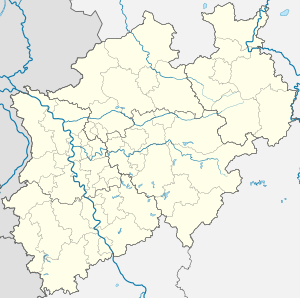Neanderthal station
Neanderthal station is a Rhine-Ruhr S-Bahn station in the town of Mettmann in the German state of North Rhine-Westphalia. It was opened on 15 September 1879. It is located in the Neandertal (Neander valley), which prior to the German spelling reform of 1901 was spelled as Neanderthal.
| Through station | |||||||||||
 | |||||||||||
| Location | Mettmann, North Rhine-Westphalia Germany | ||||||||||
| Coordinates | 51°13′40″N 6°57′11″E | ||||||||||
| Line(s) | |||||||||||
| Platforms | 2 | ||||||||||
| Other information | |||||||||||
| Station code | n/a | ||||||||||
| DS100 code | KNEA [1] | ||||||||||
| Fare zone | VRR: 540 and 640[2] | ||||||||||
| History | |||||||||||
| Opened | 15 September 1879 [3] | ||||||||||
| Services | |||||||||||
| |||||||||||
| Location | |||||||||||
 Neanderthal Location in North Rhine-Westphalia  Neanderthal Location in Germany  Neanderthal Location in Europe | |||||||||||
The reason why the outdated spelling of the station was not updated is not clear. In German, even the spelling of the Neanderthal man (whose fossils were first found in the area) has been updated to Neandertaler from the outdated Neanderthaler. The nearby Neanderthal Museum and the municipality of Mettmann have adopted the policy all names referring to the prehistoric humans have the "h", so they in fact use the spelling Neanderthaler for the species, which is not done anywhere else anymore in German-speaking areas, but even they don't spell the valley in the outdated way anymore (except seemingly in the name of the museum, which is in fact English, not German). The municipality claims that the German rail authority didn't dare to change the spelling because of the proximity of the museum.[4]
History
On 15 September 1879 the Rhenish Railway Company opened the last section of its Düsseldorf-Derendorf–Dortmund Süd railway, locally known as the Wuppertaler Nordbahn (Wuppertal Northern Railway), from Mettmann station (now Mettmann Stadtwald station) to the Rhenish Railway's Düsseldorf station.[3][5]
Along with this line Neanderthal station was also put into operation and the station building was inaugurated. This still exists today, but is no longer used for its original purpose. In the 1980s the whole station area and the station building were purchased by the landscape gardener Richard Bödeker and rebuilt as a residence. The history of the railway was considered in the design of the gardens and parks around the station and the grounds are filled with old artifacts of the railway history along the course of old Nordbahn as well as hundreds of species of bamboo and elaborately designed wall coatings and ground coverings.
The station had local importance. In addition to the two rail tracks (tracks 1 and 2), each with a platform, it had a fast reversible bypass track (track 3), three marshalling and stabling tracks (tracks 4–6), as well as a siding for freight trains to the nearby Mannesmann lime plant.[6]
Recently, the line was used only by railcars and local freight trains. On 2 January 1999, Deutsche Bahn closed passenger services over the whole line and sold Neanderthal station with a section of the line to Regionale Bahngesellschaft Kaarst-Neuss-Düsseldorf-Erkrath-Mettmann-Wuppertal mbH (shortened to Regiobahn GmbH) on 1 January 1998.[5]
Current situation
Following the acquisition of the line by Regiobahn it was upgraded for S-Bahn operations and all stations were extensively reconstructed and modernised.[5]
Neanderthal station was reduced to being just a halt (that it no longer had any sets of points), all tracks except tracks 1 and 2 were dismantled. The platform next to the station building, which had been used for the stopping of trains towards Mettmann, was demolished. Trains have since stopped at the island platform between the tracks 1 and 2. Since this platform is relatively narrow, a new platform was built for the trains towards Düsseldorf on the site of the former bypass track (track 3), which can be entered directly from the bus station.
Since 26 September 1999, the Rheinisch-Bergische Eisenbahn-Gesellschaft has operated line S 28 of the Rhine-Ruhr S-Bahn—initially every hour, but from 28 May 2000 at 20-minute intervals—from Kaarster See via Neuss Hbf, Düsseldorf Hbf and Neanderthal to Mettmann Stadtwald.[7] An extension to Wuppertal-Vohwinkel station is planned.
Rail services
The station is served by Rhine-Ruhr S-Bahn line S 28 at 20-minute intervals[8][9]
The station is also served by bus route O12 (Posener Str – Kaldenberg – Ratinger Str) operated by Rheinbahn at 20- to 60-minute intervals.[8]
References
| Wikimedia Commons has media related to Bahnhof Neandertal. |
- Eisenbahnatlas Deutschland (German railway atlas) (2009/2010 ed.). Schweers + Wall. 2009. ISBN 978-3-89494-139-0.
- "Wabenplan für das Rheinbahn-Bedienungsgebiet" (PDF). Rheinbahn. 1 August 2008. Retrieved 31 October 2019.
- "Neanderthal station operations". NRW Rail Archive (in German). André Joost. Retrieved 17 December 2013.
- "Neandertal oder Neanderthal? - Was ist denn nun richtig?" (in German). Town of Mettmann. Retrieved 17 December 2013.
- "Historie" (in German). Regiobahn. Retrieved 17 December 2013.
- "Track plan of 1965" (in Dutch). sporenplan.nl. Retrieved 17 December 2013.
- "S28: Kaarster See - Düsseldorf - Mettmann Stadtwald". NRW rail archive (in German). André Joost. Retrieved 17 December 2013.
- "Neanderthal station". NRW Rail Archive (in German). André Joost. Retrieved 17 December 2013.
- "VRR rapid-transit plan 2013" (PDF) (in German). VRR. Retrieved 17 December 2013.